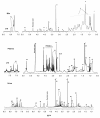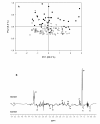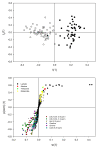Metabolomic phenotyping of a cloned pig model
- PMID: 21859467
- PMCID: PMC3174869
- DOI: 10.1186/1472-6793-11-14
Metabolomic phenotyping of a cloned pig model
Abstract
Background: Pigs are widely used as models for human physiological changes in intervention studies, because of the close resemblance between human and porcine physiology and the high degree of experimental control when using an animal model. Cloned animals have, in principle, identical genotypes and possibly also phenotypes and this offer an extra level of experimental control which could possibly make them a desirable tool for intervention studies. Therefore, in the present study, we address how phenotype and phenotypic variation is affected by cloning, through comparison of cloned pigs and normal outbred pigs.
Results: The metabolic phenotype of cloned pigs (n = 5) was for the first time elucidated by nuclear magnetic resonance (NMR)-based metabolomic analysis of multiple bio-fluids including plasma, bile and urine. The metabolic phenotype of the cloned pigs was compared with normal outbred pigs (n = 6) by multivariate data analysis, which revealed differences in the metabolic phenotypes. Plasma lactate was higher for cloned vs control pigs, while multiple metabolites were altered in the bile. However a lower inter-individual variability for cloned pigs compared with control pigs could not be established.
Conclusions: From the present study we conclude that cloned and normal outbred pigs are phenotypically different. However, it cannot be concluded that the use of cloned animals will reduce the inter-individual variation in intervention studies, though this is based on a limited number of animals.
Figures





Similar articles
-
Liquid chromatography-mass spectrometry based metabolomics study of cloned versus normal pigs fed either restricted or ad libitum high-energy diets.J Proteome Res. 2012 Jul 6;11(7):3573-80. doi: 10.1021/pr201253h. Epub 2012 May 31. J Proteome Res. 2012. PMID: 22612070
-
Obesity Development in a Miniature Yucatan Pig Model: A Multi-compartmental Metabolomics Study on Cloned and Normal Pigs Fed Restricted or Ad Libitum High-Energy Diets.J Proteome Res. 2019 Jan 4;18(1):30-47. doi: 10.1021/acs.jproteome.8b00264. Epub 2018 Oct 26. J Proteome Res. 2019. PMID: 30365323
-
Progeny of somatic cell nuclear transfer (SCNT) pig clones are phenotypically similar to non-cloned pigs.Cloning Stem Cells. 2005;7(2):119-25. doi: 10.1089/clo.2005.7.119. Cloning Stem Cells. 2005. PMID: 15971985
-
[Progress on abnormal development of cloned pigs generated by somatic cell transfer nuclear].Yi Chuan. 2020 Oct 20;42(10):993-1003. doi: 10.16288/j.yczz.20-105. Yi Chuan. 2020. PMID: 33229324 Review. Chinese.
-
Creating genetically modified pigs by using nuclear transfer.Reprod Biol Endocrinol. 2003 Nov 7;1:82. doi: 10.1186/1477-7827-1-82. Reprod Biol Endocrinol. 2003. PMID: 14613542 Free PMC article. Review.
Cited by
-
Cloning changes the response to obesity of innate immune factors in blood, liver, and adipose tissues in domestic pigs.Cell Reprogram. 2013 Jun;15(3):185-94. doi: 10.1089/cell.2012.0091. Epub 2013 May 13. Cell Reprogram. 2013. PMID: 23668862 Free PMC article.
-
Understanding host-microbiota interactions in the commercial piglet around weaning.Sci Rep. 2021 Dec 6;11(1):23488. doi: 10.1038/s41598-021-02754-6. Sci Rep. 2021. PMID: 34873196 Free PMC article.
-
Changes in the gut microbiota of cloned and non-cloned control pigs during development of obesity: gut microbiota during development of obesity in cloned pigs.BMC Microbiol. 2013 Feb 7;13:30. doi: 10.1186/1471-2180-13-30. BMC Microbiol. 2013. PMID: 23391125 Free PMC article.
-
A novel swine model for evaluation of dyslipidemia and atherosclerosis induced by human CETP overexpression.Lipids Health Dis. 2017 Sep 11;16(1):169. doi: 10.1186/s12944-017-0563-x. Lipids Health Dis. 2017. PMID: 28893253 Free PMC article.
-
The effect of high-fat diet on the composition of the gut microbiota in cloned and non-cloned pigs of lean and obese phenotype.Gut Microbes. 2013 Sep-Oct;4(5):371-81. doi: 10.4161/gmic.26108. Epub 2013 Aug 15. Gut Microbes. 2013. PMID: 23974297 Free PMC article.
References
Publication types
MeSH terms
Substances
LinkOut - more resources
Full Text Sources
Medical

